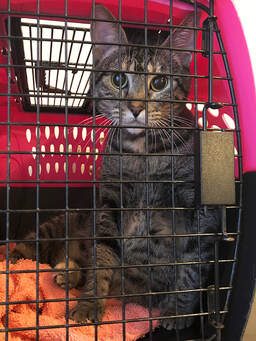
Our feline fur-iends are famous for staring!
They are the most curious of observers, whether it’s staring at you, at the wall, outside a window (for up to five hours a day) or seemingly at nothing at all. Have you ever paw-ndered the reasons for these legendary and oh-so-photogenic stares? If so, consider the following:
Whatever the breed, cats have huge eyes when compared to the size of the rest of their bodies. They also blink about twice a minute while we, as humans, blink between 15 to 20 times a minute.
Compared to humans, cats are nearsighted. The average human visual acuity is 20/20. What does this mean? It means that when our visual acuity is tested, the detail we’re able to see is from 100 to 200 feet away. Feline visual acuity, however, ranges from between 20/100 and 20/200, indicating that cats can only see clearly from 20 feet away. What’s clear to us at a distance of 100 feet, therefore, appears blurry to cats.
But whatever they lack in visual acuity, they compensate for -- thanks to other advantages. The more numerous rods in their retinas allow them to see in one-sixth the amount of light that we require. They also have a wider field of vision at 200 degrees whereas our field of vision is 180 degrees. Blessed with the ability to detect the tiniest insect or speck of dust at close range, this, paired with their superior peripheral vision, lets them fixate on things we wouldn’t even notice.
Since domesticated cats have adapted to people’s habits and use our “signals” to gather information, they don’t merely notice a person’s gaze they actually follow it. Not to mention staring at YOU!
Examples:
Affection: If your cat is staring at you through squinted eyes and giving you a slow blink while her body’s relaxed, she’s demonstrating the feline version of love and trust. Commonly referred to as cat “eye kisses,” they’re that much more meaningful when you respond to her “advances” by slow blinking back at her.
Hunger: If your cat is hungry, she may stare at you in an effort to get the message across. If it’s either close to mealtime or if she’s actually standing near her food bowl, she’ll make direct eye contact with you – often accented with a “meow” -- until her obvious request for food has been met.
Hunting: Given that cats are innately predators, they will focus on their prey by staring at them intently. Have you ever observed your own kitty staring at a bird outside the window and seeing her flinch with every movement the bird makes? This means she’s hyper-focused on staring that bird down.
Other cats: If yours is a multi-cat household, you’ve no doubt observed them staring at each other, i.e. staring each other down. Because all cats are territorial, this behavior can be one of dominance, aggression over beds or access to litter boxes or something far more pleasant such as initiating playing and wrestling.










 RSS Feed
RSS Feed